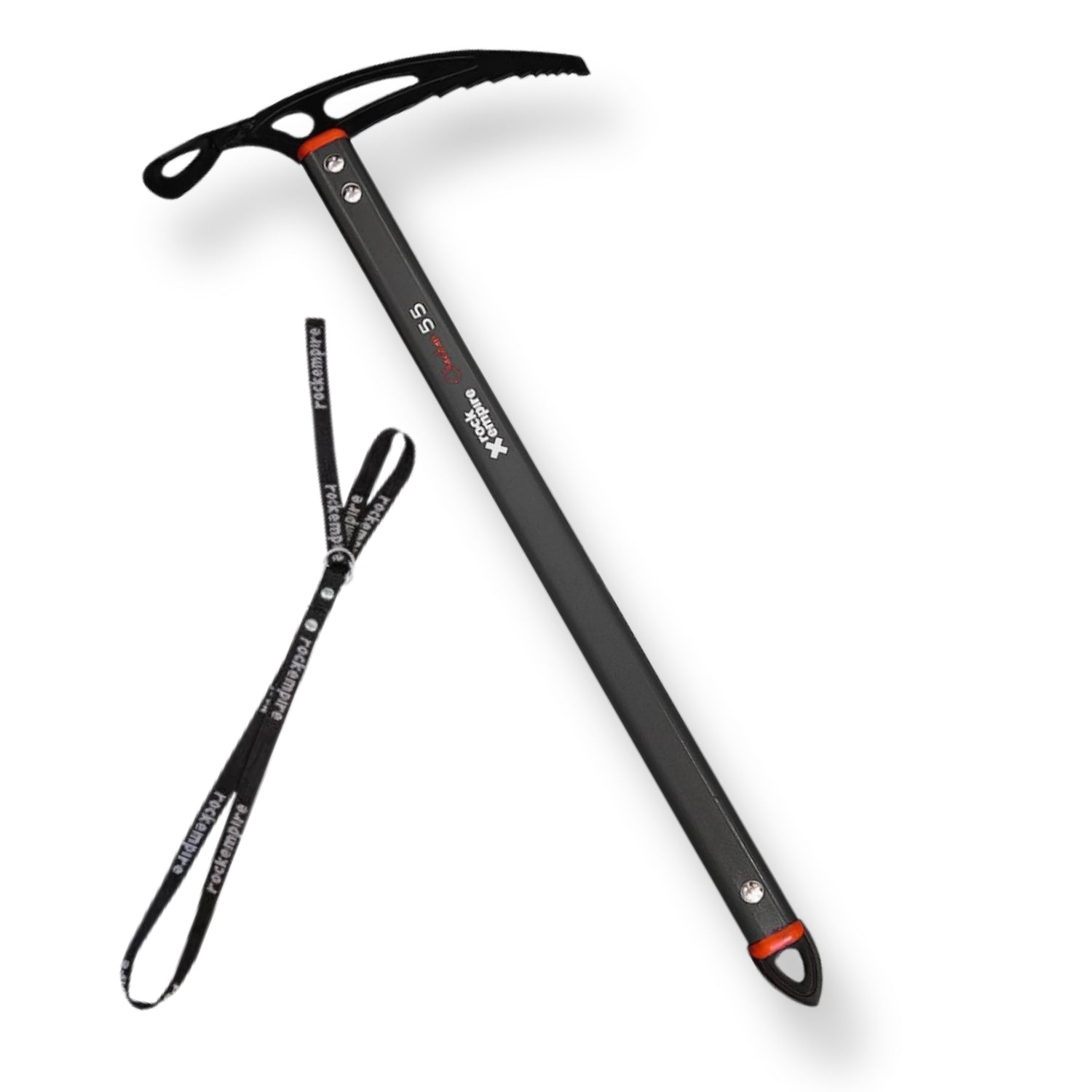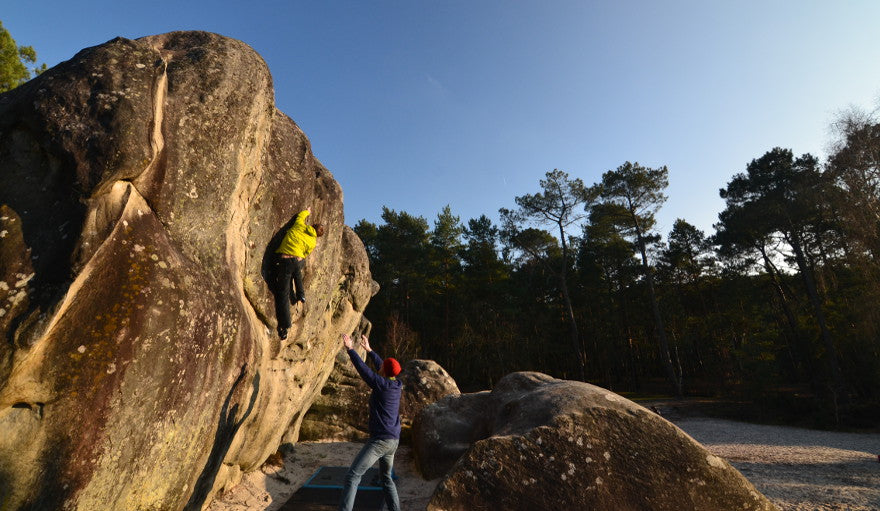By Tom Newberry
Bouldering circuits are now widely practised in many indoor walls around the UK. The basic idea behind the coloured circuits is to complete a higher volume of boulders in a shorter amount of time, which hone technique and increases both your endurance and power endurance. Circuits also give climbers a better picture of their ability levels: for example, completing every route within the red circuit (4C to 6C) indicates you are a more ‘well-rounded’ climber than maybe completing just one 7A. The notion is to achieve the highest colour possible, eventually aiming to complete the whole circuit in one session.
However, circuits were developed long before the modern bouldering wall. From the end of the 19th century the rustic forest of Fontainebleau, located one hour south of Paris, was a training site for many French Alpine climbers. Fred Bernik was the first to implement the bouldering circuit. In 1947 he innovatively placed coloured dots and arrows on the boulders, to create a tiring journey around the sandstone blocs. Different colours pertained to different approximate difficulties. Bernik would train by completing every problem within a certain circuit in the fastest time possible as physical preparation for bigger expeditions in the mountains. Historically famous mountain circuits include the Orange at both Gros Sablons and Grande Montagne and the Mauve circuit at Dame Jouanne. These problems were high in places and a fall from some was more likely to put an end to an alpine career than enhance it. It was the chaotic hillside of boulders at the quick drying Cuvier Rampart where Bernik first experimented with the circuit concept. He later went on to develop five coloured circuits around these boulders. It wasn’t long before others embraced the idea, competing to put up the harder circuits of their own or complete their peer’s circuit in a quicker time. Subsequently, these circuits became an end in themselves and over the years circuits spread to all the major climbing areas in the forest.
Above: Rhoslyn Frugtneit on the classic Black Circuit problem, Duroximanie.
Circuits have even caught on to some Swiss bouldering areas. Currently Fontainebleau contains over hundred different circuits from really easy to ridiculously hard. The very best of which combined taxing individual problems with ego-destroying examinations of a climber’s skills, from slabs and arêtes to dynos and even offwidth roof cracks. In recent years circuiting has gone out of fashion when visiting the world famous bouldering destination. It seems doing off piste problems, pushing your grade or seeking out specific forest classics are more in vogue. So why has circuiting lost its appeal to the masses? These testing coloured circuits of Font are great, for they will scrutinise your abilities as well as hone technique. No matter what grade you climb, or what grade you are attempting, these old school blocs will undoubtedly test patience before rewarding perseverance. Soon, grades become meaningless; it’s more the journey you take that’s important. Many underestimate the relatively low grades for an easy day out, some even mistake a days’ circuiting as nothing more than active rest. Poor footholds are the primary concern along with the fine sandstone texture, infamously dependent upon conditions that tend to be particular to each problem. The structure of the stone requires a mastery of techniques that need to be refined, slowly improved with time, familiarity and practice. Some say the climbing is cerebral, faith-based, and an acquired skill. What is not disputed is that completing a circuit in the world famous forest will provide one of the most rewarding and memorable day’s bouldering in your climbing career.
| Colour Circuit | Grade Range (Font) | Grade Range (V-Grade) |
| Yellow | 1A – 3C | VB – V0 |
| Orange | 2A – 4B | VB – V0 |
| Blue | 3C – 5C | V0 – V2 |
| Red | 4C – 6C | V1 – V4 |
| Black | 5B – 7A | V1 – V6 |
| White | 6B+ – 7C+ | V4 – V10 |
So what colour circuit is for you? Yellow circuits are the easiest. Problems tend to be low, accessible and user friendly. The downside to this is that many are somewhat polished. Rocher Cannon is one exception being a relatively new marked circuit. Orange circuits contain some outstanding problems tackling some unusual and aesthetic features at amenable grades. A good introduction to the bouldering circuit, orange problems should be achievable by most, don’t underestimate those 4A slabs though! Blue circuits would be a worthy challenge for those climbing around 5.10. Problems require a broad repertoire of skills, strength and good levels of endurance. A single session tick of a blue circuit in the forest is a bit of a rite of passage and attempting such a feat should be a must for all visiting climbers. Solid 5.11 climbers should aim to complete either a Red or Black circuit, although for most this usually takes a number of days or even several trips. Expect a handful of sandbags, and diverse range of styles; bringing anything but your A-game will likely end in failure. Completing a white circuit is a proud achievement, usually reserved for the extremely talented.
Above: Dave Westlake on Red 15 at Rocher Guichot.
So which crags are best for which circuits? The epic Yellow circuit at Dame Jouanne, consisting of 110 problems, is a much sought after challenge. Equally popular are the Orange at Bas Cuvier, the Blue circuits at both Apremont and Roche aux Sabots and the Reds at Isatis and Cuisiniere. Elephant hosts several good coloured circuits but the black is one of the finest in the forest. Dame Jouanne hosts the most attainable white circuit, with only one problem harder than 6C (V4), the classic highball arête L’angle Parfait 7B (V8). For something a little different the Yellow at JA Martin is also really good, long and adventurous. The idea on this circuit is to not to touch the ground the whole way round. Expect lots of jumping and bouncing and bridging alongside the more traditional skills. If, on the other hand, you wish to seek out some top quality circuits away from the crowds try one of the venues below.
Yellow – Hautes Plains
Hautes Plains offers three excellent and achievable circuits, a yellow, blue and red that all follow a similar route around the boulders. The latter of which is possibly, on paper, the easiest for its colour in the forest. The yellow follows 31 problems that lead you deeper and deeper into the dense deciduous forest. Graded from 1C (VB) to 3C (V0) most problems lie around an amenable 2C (V0). Probably too easy for most, the circuit is a pleasant outing that is suitable for beginners and kids.
Orange – 91.1
The orange circuit at 91.1 is the quintessence of the art of the Fontainebleau bloc, with the added bonus of a peaceful surrounding. Precise footwork and trusting the colourful sandstone’s friction will aid success on this challenging orange circuit. With 50 problems graded from 2B (VB) to 4B (V0), this isn’t the easiest orange circuit in the forest but it is one of the best.
Blue – Canche aux Merciers
This quick drying 44 problem circuit starts out as pleasant journey but soon turns into a real expedition. Success comes down to energy conservation, skin management and endurance. If the numbers are followed in sequence the difficulty slowly builds finishing with a crimpy climax. Yep, the crux is the final problem, a fingery marble wall that requires gas in the tank and fingers of steel. Those who want to avoid failure may wish to follow the circuit in reverse. Orange and Red are equally wonderful circuits.
Above: Tom Newberry on a crimpy circuit problem.
Red – Rocher Guichot
Rocher Guichot hosts arguably one of the finest and most diverse red circuits in Font. This is packed with some of forest’s proudest problems and contains all the essentials styles found in font classics: friction slabs, desperate mantels, steep burl, compression and balancey arêtes. With just 21 problems taking down this circuit in a day should not be an impossible task. Add on the excellent red circuit at nearby Potala (which shares the same car park) for a truly epic day out. Celebrate with a nice ‘La Vieille Ferme Rouge’.
Black – Buthiers
39 problems from 5B (V2) to 6C (V4) make up this unrelenting and technical circuit. Problem 28 is not to be under estimated! Expect a few highballs, plenty of quartz crimps and some very thin walls. Complete this circuit and you know you can rock climb well. Unfortunately, some problems stay green after periods of rain, so it is best visit after a dry spell.
White – Bas Cuvier
Whilst the previous circuits have been intentionally picked to be away from the crowds, the White circuit at perennially popular Cuvier is unquestionably the best. An anthology of world class problems will need to be negotiated with near perfect technique and super hero levels of strength. Difficulties range from 6B+ (V4) to 7C (V9), completing the entire 26 problem circuit earns one some serious bragging rights. The tour includes the world’s first 7A (V6) La Joker, the deceptively hard l’Abattoir 7A+ (V7) as well as the brutally physical Carnage 7B+ (V8), l’Aerodynamite 7B+ (V8) and l’Abbé Resina 7C (V9). Those who wish to beat the speed record will need to be topping out the final problem in less than 20 minutes. Bon Chance!
ED+ - Cuisinière
The ED+ circuit at Cuisinière is the hardest circuit in Fontainebleau and despite being decades old, it's only ever been climbed once in a day, by Nalle Hukkatival. The fact alone that the very last boulder on the circuit is the infamous slab Duel (8A) has kept it an exclusive challenge. On completing the circuit Nalle commented “I found the circuit to be a real test of climbing skill - being strong will only get you so far. The boulders range between every style testing technique above all. Crimps, slopers, slabs, aretes, dynos, highballs, mantles - you have it all. Mental strength is needed on the highballs. In order to make it through the entire circuit I needed to consistently climb well and efficiently. It feels great to complete something that I remember seeing in the guidebook and laughing at because it seemed so ridiculously hard.”


















